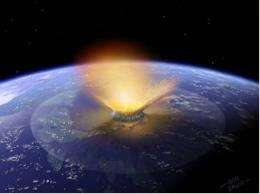August 31, 2010 report
Study suggests dinosaurs killed off by more than one asteroid

(PhysOrg.com) -- Dinosaurs, along with over half of other species, became extinct at the end of the Cretaceous period about 65.5 million years ago, and many scientists believe this was due to a single impact with an asteroid that hit at Chicxulub in the Gulf of Mexico. Now a study published in the Geology journal proposes the impact that produced the Boltysh crater in the Ukraine may also have been involved in the extinctions, and there may have been a shower of asteroids or comets.
Professor David Jolley of Aberdeen University in Scotland, and Professor Simon Kelley of the Open University, led a team studying the Boltysh crater, which was discovered in 2002. The Boltysh crater is only 24 kilometers in diameter and therefore much smaller than the Chicxulub at over 180 km across.
The team studied fossilized plant pollen and spores found in the mud that filled the Boltysh crater, and found that ferns colonised the area soon after the impact, but there was another colonisation a meter above the first, suggesting a second asteroid impact had occurred elsewhere causing repeat devastation. The researchers attributed this second spike, which occurred two to five thousand years later, to the aftermath of the Chicxulub impact.
Ferns are known to colonise devastated areas rapidly after disasters, so layers of fern spores known as "fern spikes" are considered to be good indicators of impact events in the past.
The theory that an asteroid impact caused the extinction of the dinosaurs and other species was first put forward in 1980, at which time it created a great deal of controversy until the crater at Chicxulub was discovered and dated to 65 million years ago.
Other theories for the mass extinctions include enormous volcanic eruptions of the Deccan Traps in India about the same period that would have spewed toxic gases into the atmosphere. There is also a theory the asteroid impact triggered global earthquakes that in turn caused the Deccan Traps eruptions.
Professor Kelley said it is possible evidence will be found in future for more impact events around the same time, suggesting dinosaurs and many other species may have been wiped out due to the effects of an asteroid shower lasting thousands of years.
More information: Two large meteorite impacts at the Cretaceous-Paleogene boundary, David Jolley et al., Geology, v. 38 no. 9 p. 835-838. doi:10.1130/G31034.1
© 2010 PhysOrg.com


















